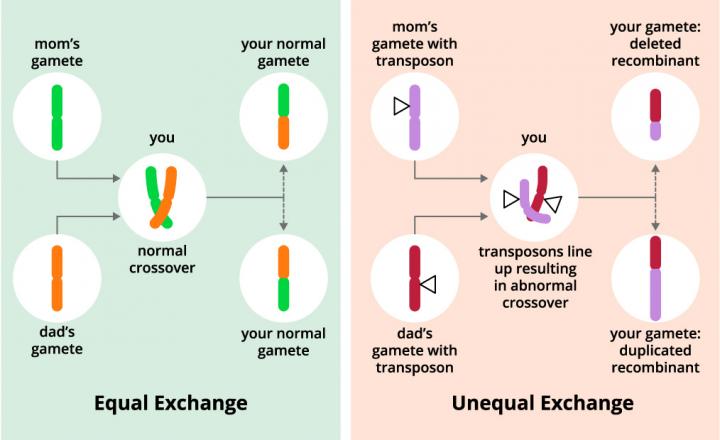
Rochester Scientists Identify Gene That Regulates Recombination Rates

During sexual reproduction, chromosomes transmitted via the mother and the father's gametes (egg and sperm) are shuffled to produce a genetic combination unique to each offspring. In most cases, the chromosomes line up properly and crossover (left panel). The unequal crossover (right panel) occurs because of "selfish DNA" sequences known as transposons, represented here as triangles. When abnormal crossovers occur, chromosomes do not line up properly and important genes may be duplicated or deleted.
Credit: University of Rochester illustration / Michael Osadciw
Scientists have long recognized that the exchange of genetic material by crossing over–known as recombination–is vital to natural selection. Yet some species display far more crossover than others. Why? Researchers hypothesize that crossover rates have evolved to balance the benefits of crossing over with the risks of selfish DNA.
“There's a bit of a mystery being solved now about how certain molecular, biological, and genome phenomena have evolved in response to selfish genetic elements,” says Daven Presgraves, a dean's professor of biology at the University of Rochester. “The role of natural selection in an ecological context is essentially a solved problem, but the role of natural selection in response to selfish genetic elements is still being worked out.”
Presgraves and PhD candidate Cara Brand recently accomplished an important milestone in learning about these evolutionary dynamics. By studying two species of fruit flies, they discovered a gene, MEI-218, that controls the rate of recombination. In a paper published in Current Biology, they explain how MEI-218 controls differences in the rate of crossing over between species and the evolutionary forces at play.
“This is the first gene I know of that anyone has shown to be responsible for the evolution of recombination rates,” Presgraves says.
The team focused on two closely related species of fruit flies–Drosophila melanogaster and its sister species, Drosophila mauritiana–because large differences have evolved in their rates of recombination: D. mauritiana does about 1.5 times more crossing over than D. melanogaster. When they compared genes in the two different species, the researchers found that the DNA sequences of MEI-218 were extraordinarily different.
“Natural selection works best when there's a diversity of genotypes to act upon,” says Brand, the lead author of the paper. “Shuffling combinations of alleles through recombination generates the diversity upon which natural selection acts.”
Recombination is therefore important for two main reasons:
1. Imagine two chromosomes with genes A and B. On one chromosome you might have a “good” (beneficial) A allele and a “bad” (deleterious) B allele. On the other chromosome you might have the opposite; a bad A allele and a good B allele. Which chromosome would be a better? “It's a mixed bag where one chromosome can't necessarily outcompete the other,” Brand says. “Recombination can shuffle our allele combinations so that one chromosome can end up with the good A and B alleles together, while the other can get the bad A and B alleles together. Now when these chromosomes compete, the two good alleles will win out in future generations.”
2. We have combinations of alleles that are good in our current environment, but the environment is always changing. The good alleles that are adaptive and healthy now may not be so in the next generation. Recombination can shuffle these combinations of genes so that some will be bad and those offspring will die, but some will be good and these offspring will survive.
“Recombination is important–it's not hard to convince anyone of that–but when we look across different species, we see that the rates of crossing over are different,” Brand says. “Why increase or decrease the recombination rate?”
There is no single ideal rate or distribution of crossovers, Brand says. Crossovers are necessary to produce viable offspring, but crossing over also has risks. Selfish DNA sequences known as transposons–repetitive genetic elements that do not seem to have benefits to their hosts–are distributed throughout the genome. Transposons are akin to viruses, but instead of injecting themselves in cells, they invade genetic material. If abnormal crossovers occur between transposons in different locations on the chromosomes, the chromosomes do not line up properly and important genes may be duplicated or deleted.
Brand and Presgraves hypothesize that the change in recombination rates between D. mauritiana and D. melanogaster may have evolved because the species have different amounts of transposons in their genomes. The D. melanogaster genome has more transposons than D. mauritiana, so D. melanogaster may therefore have evolved a lower rate of crossing over in order to avoid the higher risk of harmful crossovers between transposons.
This means, then, that the MEI-218 gene is constantly evolving to an ever-changing optimum. The evolution of MEI-218 is similar to genes involved in immunity, Presgraves says. “That should make some intuitive sense because genes involved in immunity are constantly adapting to the changing community pathogens that are challenging us all the time.”
Evolutionary biologists refer to these kinds of evolutionary dynamics as “evolutionary arms races” because, through positive natural selection, genes are chasing a constantly changing fitness optimum. “Maybe you just adapted, but a few generations from now you're not at the optimum anymore. You have to evolve again and again and again,” Presgraves says.
The MEI-218 gene has so far only been investigated in fruit flies, but the research into recombination has applications for humans. “During meiosis at least one crossover per chromosome, in general, is required to make sure the chromosomes separate properly,” Brand says. “Either a lack of crossing over or crossing over in the wrong regions of the genome is what leads to many birth defects like Down Syndrome.”















